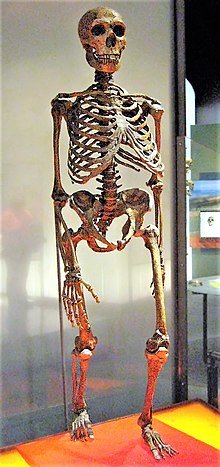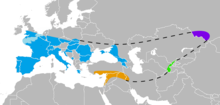နဏ္ဍသဲ
| Neanderthal | |
|---|---|

| |
| An approximate reconstruction of a Neanderthal skeleton. The central rib-cage (including the sternum) and parts of the pelvis are from modern humans. | |
| မျိုးရိုးခွဲခြားခြင်း | |
| လောက: | Animalia |
| မျိုးပေါင်းစု: | Chordata |
| မျိုးပေါင်း: | Mammalia |
| မျိုးစဉ်: | Primates |
| မျိုးစဉ်သေး: | Haplorhini |
| Infraorder: | Simiiformes |
| မျိုးရင်း: | Hominidae |
| မျိုးရင်းသေး: | Homininae |
| မျိုးဇာတ်: | Hominini |
| မျိုးစု: | Homo |
| မျိုးစိတ်: | †H. neanderthalensis
|
| ဒွိနာမ | |
| Homo neanderthalensis King, 1864
| |

| |
| Known Neanderthal range in Europe (blue), Southwest Asia (orange), Uzbekistan (green), and the Altai Mountains (violet) | |
| Synonyms[၆] | |
|
Homo
Palaeoanthropus
Protanthropus
| |
နဏ္ဍသဲ (ဟိုမို နဏ္ဍသဲလန်စစ် သို့ ဟိုမိုဆေပျံ နဏ္ဍသဲလန်စစ်) သည် မျိုးတုံးသွားပြီဖြစ်သော ပေါရာဏမနုဿတို့အနက် မျိုးစိတ်တခုဖြစ်သည်။ ယူရေးရှား၌ လွန်ခဲ့သော နှစ် ၄၀၀၀၀ ခန့်အထိ နေထိုင်ဖူးသည်။ ခေတ်သစ်လူတို့၏ ဂျီနုမ်းနှင့်တူလာခြင်း၊ ရာသီဥတုအပြောင်းအလဲ၊ ရောဂန္တရကပ်၊ တခုခု သို့မဟုတ် အကြောင်းအကျိုးအစုံသုံး၍ ၎င်းမျိုးအကုန်တုံးခြင်း ဖြစ်တန်ရာ၏။ ၎င်းတို့နေရာကို အစောပိုင်း ဥရောပသား ခေတ်သစ်လူတို့က နေရာဝင်ယူသည်။
ခေတ်သစ်လူနှင့် နဏ္ဍသဲတို့အကြား ထင်သာမြင်သာရှိသော စည်းဟူ၍ မတားနိုင်။ လေ့လာချက်များအရ နှစ် ၃၁၅၀၀၀ မှသည် ၈၀၀၀၀၀ အထိ အဟအထပ်ရှိနေသည်။ နဏ္ဍသဲနှင့် ၎င်း၏ဘိုးဘေး အိက် ဟိုင်ဒယ်ဂါဂျန်စစ်သည်လည်း ထိုနည်း၎င်းပင်။ အစောဆုံးတွေ့ရသော နဏ္ဍသဲဟုယူနိုင်သည့် အရိုးများမှာ လွန်ခဲ့သော နှစ် ၄၃၀၀၀၀ ကဟု ဖော်ပြနေသည်။ သို့သော်လည်း အရိုးကပင် မသဲကွဲလေရာ အဖြေသည်လည်း မထင်ရှားတော့။ နဏ္ဍသဲတို့ရှိကြောင်းကိုမူ နှစ် ၁၃၀၀၀၀ သက်တမ်းရှိ အရိုးအများက သက်သေခံနေသည်။ နဏ္ဍသဲ-၁ ကို ၁၈၅၆ ခုတွင် ယခု ဂျာမနီပိုင်ဖြစ်လာမည့် နဏ္ဍာတောင်ကြား၌ စတွေ့ရသည်။ ဟုတ်မဟုတ် စစ်မစစ် ငြင်းကြခုန်ကြအပြီးတွင် ၂၀ ရာစုအစောပိုင်း အသိပညာများကြောင့် နဏ္ဍသဲကို သုတေသီတို့က ခပ်တုံးတုံး ကျောက်ခေတ်လူအဖြစ်သာ ယူကြသည်။ သို့သော် သိပ္ပံဆိုင်ရာအသိုင်းအဝိုင်းတွင် အသိအမြင် ဗဟုသုတ တိုးတက်လာသည်နောက် အသိဉာဏ်မဖွံ့ဖြိုးသော ဂူအောင်းလူတို့အား အထင်အမြင်သေးခြင်းသည်လည်း ယဉ်ကျေးမှုအရ ပြောင်းလဲသွားသည်။
နဏ္ဍသဲတို့သုံးသော နည်းပညာတို့မှာ အတန်ကလေး ရှုပ်ထွေးသည်။ ၎င်းတွင် ကျောက်လက်နက်နယ်ပယ်လည်း အဝင်အပါဖြစ်သည်။ မီးကိုဖန်တီးခြင်း၊ ဂူတွင်း၌ မီးလင်းဖိုဆောက်ခြင်း၊ ဘုစပတ်စေးဖြင့် စောင်နှင့် တဘတ်ကြီးတို့လုပ်ကာ ရိုးစင်းသောအဝတ်များ ထွင်ခြင်း၊ မြေထဲပင်လယ်၌ ရွက်လွှင့်ခြင်း၊ ဆေးပင်များ အသုံးချခြင်း၊ ဒဏ်ရာကုခြင်း၊ အစာလှောင်ခြင်း၊ ကင်ပြုတ်ကျပ်တင် စသော ချက်နည်းများ ထွင်ခြင်းတို့ကိုလည်း လုပ်ခဲ့သည်။
အချို့လည်း ဘာသာတရားပင် ပေါ်ပေါက်ပြီ ဆိုသည်။ စကားပြောနိုင်စွမ်းရှိပြီး တုပပြောနိုင်သည်မှာ သေချာသည်။ ဘာသာစကား ရှုပ်ရှုပ်ထွေးထွေးကိုမူ အသုံးနိုင်သေး။
ခေတ်သစ်လူတို့နှင့်နှိုင်းလျှင် နဏ္ဍသဲတို့သည် တုတ်တုတ်ခိုင်ခိုင်ရှိပြီး အချိုးအစားအရ ခြေလက်မှာ တိုသည်။ ခြေလက်တိုခြင်း၏ကောင်းကွက်ကို သုတေသီတို့က အေးသောဥတုတို့၌ ကိုယ်တွင်းအပူကို ထိန်းနိုင်ရန်ဟု သုံးသပ်သည်။ သို့သော် နဏ္ဍသဲတို့မှာ တောထူသောနေရာတို့၌နေ၍၎င်း၊ လှုပ်လှုပ်ရှားရှားပြု၍ ကိုယ်ကို နွေးအောင်လုပ်ရန်ကို၎င်း သိနှင့်လေပြီ။ သို့သော်လည်း ကိုယ်တွင်းအဆီလှောင်မှုကို အဓိကထားသည်ကိုကြည့်၍ အအေးပိုင်းနှင့်ကိုက်သောကိုယ်ရှိခြင်းမှာ သေချာသည်။ လေနွေးနွေးဝင်ရန် နှာခေါင်းပေါက်ကျယ်ကျယ်လည်း ပါသည်။ (နှာခေါင်းမှာ ဗီဇအပြောင်းအလဲကြောင့်လည်း ဖြစ်နိုင်သည်။) ပုံမှန် နဏ္ဍသဲ ယောက်ျားသည် ၁၆၅ စင်တီ (၅ ပေ ၅ လက်မ) ရှည်ပြီး အမျိုးသမီးတို့မှာ ၁၅၃ စင်တီ (၅ ပေ) မျှ အရပ်ရှည်သည်။ စက်မှုခေတ်မရောက်မီ ခေတ်သစ်လူတို့အရပ်မျှ ဖြစ်သည်။ ဦးနှောက်အိမ်မှာ နဏ္ဍသဲအမျိုးသားတွင် ၁၆၀၀ ကုဗစင်တီ (၉၈ ကုဗလက္မ) နှင့် အမျိုးသမီးတွင် ၁၃၀၀ ကုဗစင်တီ (၇၉ ကုဗလက္မ) ရှိကြသည်။ လက်ရှိ ခေတ်သစ်လူတို့၏ ပမာဏအတိုင်းပင်။[၁]
ကိုးကား
[ပြင်ဆင်ရန်]- ↑ ၁.၀ ၁.၁ Haeckel၊ E. (1895)။ Systematische Phylogenie: Wirbelthiere (ဂျာမန်ဘာသာစကားဖြင့်)။ G. Reimer။ p. 601။
- ↑ Schwalbe၊ G. (1906)။ Studien zur Vorgeschichte des Menschen [Studies on the pre-history of man] (ဂျာမန်ဘာသာစကားဖြင့်)။ Stuttgart, E. Nägele။ doi:10.5962/bhl.title.61918။ hdl:2027/uc1.b4298459။
- ↑ Klaatsch, H. (1909). "Preuves que l 'Homo Mousteriensis Hauseri appartient au type de Neandertal" (in fr). L'Homme Préhistorique 7: 10–16.
- ↑ Romeo၊ L. (1979)။ Ecce Homo!: a lexicon of man။ John Benjamins Publishing Company။ p. 92။ ISBN 978-90-272-2006-6။
- ↑ ၅.၀ ၅.၁ ၅.၂ ၅.၃ ၅.၄ McCown၊ T.; Keith၊ A. (1939)။ The stone age of Mount Carmel. The fossil human remains from the Levalloisso-Mousterian။ 2။ Clarenden Press။
- ↑ Szalay၊ F. S.; Delson၊ E. (2013)။ Evolutionary history of the Primates။ Academic Press။ p. 508။ ISBN 978-1-4832-8925-0။
